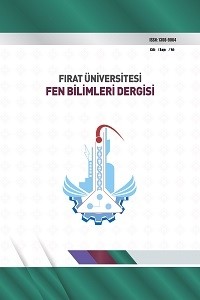QR Algoritması Kullanarak Spektral Çizge Bölümleme
Çizge bölümleme, Çizge teorisi, Çizge görselleştirme.
Spectral Graph Partitioning Using QR Algorithm
Graph partitioning, Graph theory, Graph visualization.,
___
- [1] N. Deo, Graph theory with applications to engineering and computer science. Courier Dover Publications,2017.
- [2] A. Kaveh, Structural mechanics: graph and matrix methods. Macmillan International Higher Education,1992, vol. 6.
- [3] J. G. F. Francis, “The QR Transformation A Unitary Analogue to the LR Transformation—Part 1,” The Computer Journal, vol. 4, no. 3, pp. 265–271, Jan. 1961, ISSN: 0010-4620. DOI: 10.1093/comjnl/4.3.265. eprint: https://academic.oup.com/comjnl/article-pdf/4/3/265/1080833/040265.pdf.[Online]. Available: https://doi.org/10.1093/comjnl/4.3.265.
- [4] A. Buluç, H. Meyerhenke, I. Safro, P. Sanders, and C. Schulz, “Recent advances in graph partitioning,” in Algorithm Engineering: Selected Results and Surveys, L. Kliemann and P. Sanders, Eds. Cham: Springer International Publishing, 2016, pp. 117–158, ISBN: 978-3-319-49487-6. DOI: 10 . 1007 / 978 - 3 - 319 - 49487-6_4. [Online]. Available: https://doi.org/10.1007/978-3-319-49487-6_4.
- [5] B. Hendrickson and R. Leland, “An improved spectral graph partitioning algorithm for mapping parallel computations,” SIAM Journal on Scientific Computing, vol. 16, no. 2, pp. 452–469, 1995. DOI: 10.1137/0916028. eprint: https://doi.org/10.1137/0916028. [Online]. Available: https://doi.org/10.1137/0916028.
- [6] T. Uçkan, C. Hark, E. Seyyarer, and A. Karcı, “Ağırlıklandırılmış çizgelerde tf-idf ve eigen ayrışımı kullanarak metin sınıflandırma,” Bitlis Eren Üniversitesi Fen Bilimleri Dergisi, vol. 8, no. 4, pp. 1349–1362,2019, ISSN: 2147-3129. DOI: 10.17798/bitlisfen.531221.
- [7] R. Merris, “Laplacian matrices of graphs: A survey,” Linear Algebra and its Applications, vol. 197-198, pp. 143–176, 1994, ISSN: 0024-3795. DOI: https : / / doi . org / 10 . 1016 / 0024 - 3795(94 ) 90486 - 3. [Online]. Available: https : / / www . sciencedirect . com / science / article / pii / 0024379594904863.
- [8] A. Gusrialdi and Z. Qu, “Distributed estimation of all the eigenvalues and eigenvectors of matrices associated with strongly connected digraphs,” IEEE Control Systems Letters, vol. 1, no. 2, pp. 328–333, 2017. DOI: 10.1109/LCSYS.2017.2717799.
- [9] R. T. Kobayashi and T. Abrão, “Stability analysis in gram-schmidt qr decomposition,” IET Signal Processing, vol. 10, no. 8, pp. 912–917, 2016. DOI: https://doi.org/10.1049/iet-spr.2016.0123. eprint:https://ietresearch.onlinelibrary.wiley.com/doi/pdf/10.1049/iet- spr.2016.0123.[Online]. Available: https://ietresearch.onlinelibrary.wiley.com/doi/abs/10.1049/iet- spr.2016.0123.
- [10] D. Watkins, “Understanding the qr algorithm, part ii,” SIAM Review, vol. 24, Oct. 1982. DOI: 10.1137/1024100.
- [11] M. Dileo. “Doctor Who dataset.” (), [Online]. Available: https://www.kaggle.com/manueldileo/doctor-who-dataset. (accessed: 06.06.2022).
- [12] M. Bastian, S. Heymann, and M. Jacomy, “Gephi: An open source software for exploring and manipulating networks,” 2009. [Online]. Available: http://www.aaai.org/ocs/index.php/ICWSM/09/paper/view/154.
- ISSN: 1308-9064
- Yayın Aralığı: Yılda 2 Sayı
- Başlangıç: 1987
- Yayıncı: Soner ÖZGEN
Spor Biyomekaniğinde Performans Analizi için Hareket Yakalama Teknolojisi Uygulamaları
Kübra Elif TOZKOPARAN, Özgür KARADUMAN
Biyokütle Kaynaklarından Bazı Platform Kimyasallarının Birlikte Üretimi
Abdulkadir GÜL, Muhammed TANYILDIZI
EDR Ürünleri Kullanılarak Uç Nokta Görünürlüğünün Sağlanması
Kevser Mehveş DAĞCI, Sengul DOGAN, Türker TUNCER
Kısıtlı Konut Hacimlerinde Tasarım Yaklaşımı
Betül İrem TEMİZ, Şengül YALÇINKAYA
Kendinden Helisel Kanatlı Boruların Isı Transfer Performansını Artırmaya Yönelik Yeni Bir Yaklaşım
Cihan ÖZEL, Cevher Kürşat MACİT, Ali TAŞKIRAN, Meral ÖZEL
Doğal Peyzajların Turizm Açısından Ekonomiye Katkıları: Bursa Sadağı Kanyonu Tabiat Parkı
Nurhan KOÇAN, Ferda Nur BUDAK ÇETİN
Meme Kanserinin Tespiti için Yapay Zekâ Tabanlı Hibrit Bir Model Önerisi
Feyzi Ferat ATEŞ, Abidin ÇALIŞKAN, Mesut TOĞAÇAR
Güneş BAŞBAĞ, Oktay KARADUMAN, Mustafa BOYRAZLI, İskender ÖZKUL, Canan AKSU CANBAY
Selçuk KARATAŞ, Emrah ÇELİK, Mustafa BOYRAZLI, Elif ARANCI ÖZTÜRK, Canan AKSU CANBAY, Gökhan DOĞANTEPE
